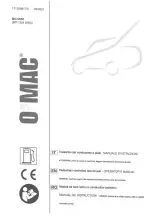
61
Maintenance Instructions
CHECKING/SERVICING/
REPLACING/REPAIRING
•
With an operator in the seat, the engine starts but
dies soon after the Forward Speed Control (FSC) or
PTO is engaged.
•
Without
an operator on the seat, the engine starts
and continues to run with the Forward Speed Control
(FSC) and/or PTO engaged.
•
With an operator in the seat, the Forward Speed
Control (FSC) and PTO disengaged and panel horn
works, but the starter is not engaging.
Forward Speed Control Friction Lock
The FSC friction lock is designed to
hold the se-
lected forward travel speed
when the steering le-
vers are moved and yet the friction is not too heavy
to make
moving the FSC control
difficult (too much
friction). The procedure for checking the FSC fric-
tion lock is as follows:
1. Place the FSC in the full
FORWARD
position
and pull both steering levers back; the FSC le-
ver should not move. If the FSC lever moves
back when the steering levers are pulled back,
the
friction needs to be increased.
2. With the steering levers held back, move the
FSC lever back from the
FORWARD
position.
With a proper amount of friction adjusted, the
FSC lever should move back with a slight
amount of resistance (friction). If the FSC lever
movement is “stiff”,
the friction needs to be
decreased.
If the FSC friction lock needs to be adjusted, contact
your Walker dealer or refer to the Walker Service
Manual.
REPLACING/REPAIRING
DANGER
To prevent accidental starting of the en-
gine when replacing parts or repairing the
machine, remove the key from the ignition
switch and disconnect the spark plug
wires.
IMPORTANT:
ALWAYS
use genuine factory re-
placement parts. Substitute parts
CAN
result in
product malfunction and possible injury to the op-
erator and/or others.
Drive Belts
There are
four (4) individual belts
on GHS models
or
three (3)
belts on SD models:
•
Engine PTO Drive Belt (3 Groove Power Band)
•
Jackshaft Drive Belt
•
GHS Blower Drive Belt (GHS Model Only)
•
Hydrostatic Ground Drive Belt
The belts may be removed and replaced using the
procedures described on the following pages.












































